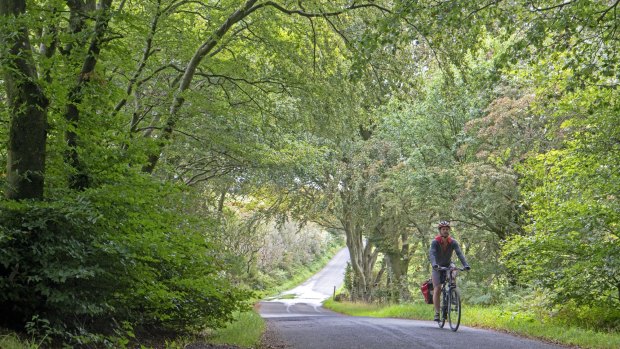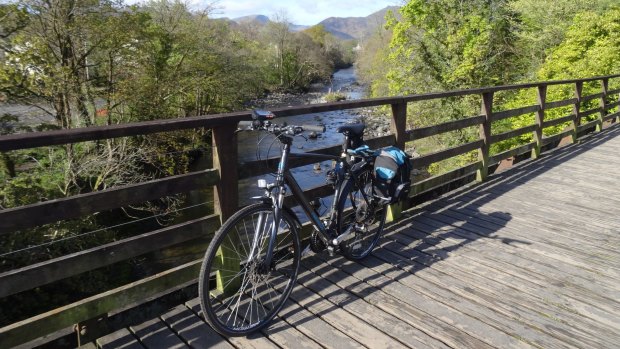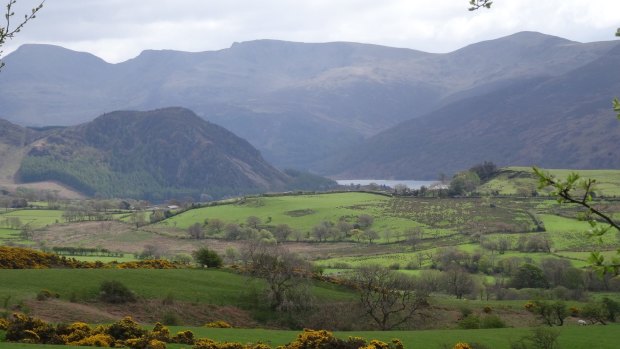This was published 2 years ago
England's Coast to Coast cycling route: A four-day ride from Wuthering Heights to James Herriot
By Andrew Bain

xxEnglandcycle cycle cycling bike biking uk england ; text by Andrew Bain cr: Andrew Bain (image supplied via journalist for use in Traveller ONLY, no syndication, fee applies) UTracks runs a six-day, self-guided Cyclists Coast to Coast trip from from Whitehaven to TynemouthCredit: Andrew Bain
On a bicycle, the moors of England's Pennines mountains can go from Wuthering Heights to James Herriot in minutes. One moment I'm cycling beside the burnt-out shell of a cafe atop Hartside, with no colour to the barren land except the fading final flowers of the heather. Minutes later I'm in a valley approaching England's highest market town, riding between green fields and Jenga-perfect dry-stone walls, with sheep and Highland cattle as shaggy as haystacks incuriously watching me pass.
I'm halfway across the island, two days into my bike ride across northern England on the Sea to Sea cycle route, a ride better known as the Coast to Coast.
Crossing from the Irish Sea to the North Sea, its the most popular long-distance bike ride in Britain, drawing thousands of cyclists up and across the Pennines every year. With scenes like these marvellous moors and the relative simplicity of the goal – three or four days of pedalling to traverse a country – it's hardly surprising.

The Coast to Coast route is he most popular long-distance bike ride in Britain, drawing thousands of cyclists every year.Credit: John Millen
Atop the Pennines, I'll cross the high point of Britain's entire 25,000-kilometre National Cycle Network, and yet I'm surprised to find that I'm enjoying this mountain crossing more than any other part of the 219-kilometre ride.
That's despite the fact that the Lake District, England's most poetic and whimsical region, is now behind me. I left it just this morning, and it was as gorgeous as Wordsworth and Wainwright would have you believe. Yet there's something even more compelling about these bleak and inexplicably beautiful high moors and the quiet roads that cut through them.
The Coast to Coast ride begins beside a slipway in the town of Whitehaven, on the edge of the Lake District. Said to be the town on which New York's street grid system was modelled, Whitehaven is slow to release cyclists, with the ride winding through its long tail of suburbs.

The Lake District, England's most poetic and whimsical region.Credit: John Millen
Soon, however, I'm climbing gently away from town along the former Ennerdale Railway, which rises almost imperceptibly towards the Lake District National Park, a curious land wrapped around 16 lakes where mountains are called "fells" and waterfalls are "forces".
Close to 16 million people visit the Lake District every year, but until I reach my first night's stop in Keswick, I see barely a dozen of them. Sheep are my main companions as the ride adheres to quiet country lanes, passing three lakes and cutting through shortbread-tin villages where signs implore motorists to slow down, not for the presence of children but for red squirrels.
With its architecture like something from a Shakespearean imagination, Keswick is an indoor town with an outdoors personality. Among stores with names like Ye Olde Friars and Old Keswickian, mountain bikers cruise its streets and rock climbers practice their limber art on stone walls beside Derwentwater lake.
Far older than even Keswick's medieval architecture is Castlerigg, a stone circle atop a hill outside of town that pre-dates Stonehenge and the Giza Pyramids. It's a steep, if short, climb on a bike to the stone circle, and beside the road near the top is a seat carved with the therapeutic offer to "rest your bones on the way to the stones". I'm tempted, but I've cycled just two kilometres from Keswick and this is the longest day of my ride – 75 kilometres to Alston. I pedal on.
By late morning, as I near Penrith, there's a momentary lapse in the mountains.
The fells of the Lake District are suddenly behind me, and the Pennines rise ahead. As my pace picks up, I roll through Greystoke, which some have suggested as the Greystoke of the Tarzan story.
On a map, the climb into the Pennines looks like the Coast to Coast's most difficult moment, rising almost 500 metres from Renwick to Hartside, but it's a climb on which scenery trumps any struggle. Britain's Automobile Association once rated the road over Hartside as one of the world';s 10 best drives, and even when the sky is as bleak as the moors into which I'm rising, it's hard to think of many finer bits of cycling than the day and a half ahead of me.
The climb to Hartside isn't steep, and soon I'm coasting downhill to my night's stop in Alston. England's highest market town is better known for the fact that its bachelors once issued a public plea for single women to move to the town – with men outnumbering women by 10 to one, the town had Britain's most lopsided population.
The design of the ride from Alston across the Pennines is simplicity itself, even if the effort isn't. Roads cut straight across the grain of the mountains, plunging into valleys and villages and climbing steeply back out. Rinse and repeat.
One moment I'm descending on a 25 per cent gradient into Nenthead, feeling almost as though I'm abseiling into town, and the next I'm struggling up a 17 per cent climb towards Black Hill, the highest point (608 metres) on the National Cycle Network.
Through it all are scenes ripped straight from a postcard – villages that look like stone quarries stacked into shape, and fields that seem to glow green inside the brown frame of the moors. Red grouse scatter from the heather as I pass, and on the long descent into Rookhope, the road is lined with reminders of the Pennines' mining days. An abandoned headframe stands beside an old lead mine, and there's the evocative arch of a horizontal chimney, looking like a bridge lost beside a stream.
I stay this final night in Stanhope, sharing a B&B with a young English couple on their first cycle tour. The hills have taken their toll, and when the owner of the B&B mentions that she's had cyclists ask to be driven up the hill out of Stanhope, they look almost tempted by the idea. But it's also the final climb of the ride, even though Tynemouth is still 65 kilometres away. They fill themselves with resolve and a full English breakfast, and pedal on.
Atop the climb, there's a final short roll across the tops of the Pennines before the ride turns away onto the Waskerley Way, a disused rail line that gently lowers me onto the coastal plain of north-east England.
It's a gloriously removed section of riding, out of sight of roads as it rounds a lake, with wind turbines down the valley cutting at the sky. Birds take off ahead of me and hang stationary as they try to fly into the wind, and there's a sense of being in high alpine country even though I'm barely 400 metres above sea level.
Even through the mass of towns around Tyneside, green corridors and old railways lead me quietly towards the North Sea, until finally I join the banks of the Tyne River – and the ramparts of Hadrian's Wall – through Newcastle and out to the sea at Tynemouth.
At the coast, breakwaters reach across the river mouth like tongs and the remains of a castle and priory lie crumbled across a headland. The sound of seagulls is in my ears for the first time in four days, providing a true coastal welcome as I finally park my bike beside the sea once more.
THE DETAILS
FLY
The nearest airports to the start and finish of the ride are Manchester, which has rail links to Whitehaven, and Newcastle-upon-Tyne, which is connected by the metro rail to Tynemouth. Emirates flies daily to both cities from Sydney and Melbourne. See emirates.com/au
CYCLE
UTracks runs a six-day, self-guided Cyclist's Coast to Coast trip (from $1250), including four days of riding from Whitehaven to Tynemouth, with all accommodation, maps, route notes and baggage transfers included. Trips run from April to October. See utracks.com
MORE
Andrew Bain paid for his travel to England and cycled courtesy of UTracks.
FIVE MORE BRITISH BIKE RIDES
LON LAS CYMRU
Traverse Wales south to north on this hilly and spectacular 400- kilometre ride from Cardiff to Holyhead.
CAMEL TRAIL
A 27-kilometre day ride on a disused railway along the Camel River estuary from the Cornish coast into Bodmin Moor.
HEDRIDEAN WAY
Launched in 2016, this 300-kilometre ride crosses the Outer Hebrides – 10 Scottish islands linked by causeways and ferries.
NORTH COAST 500
This newly marketed 830-kilometre road trip, looping north from Inverness, has become hugely popular with cyclists.
LAND'S END TO JOHN O'GROATS
Go the whole hog – south to north through Great Britain – on this ever-popular, pick-your-own-path route. It's possible to do it entirely on the National Cycle Network.
Sign up for the Traveller Deals newsletter
Get exclusive travel deals delivered straight to your inbox. Sign up now.